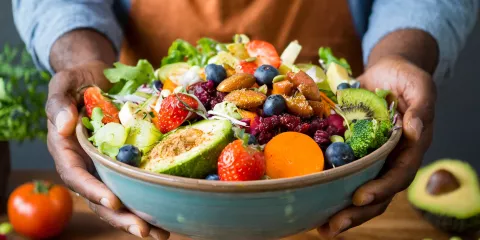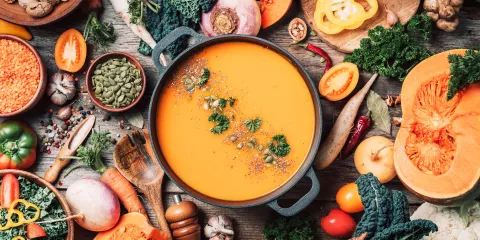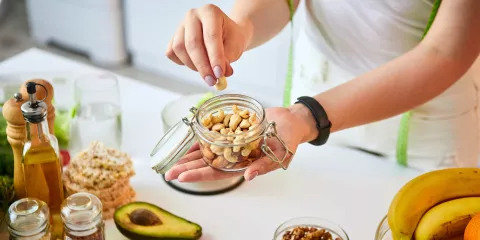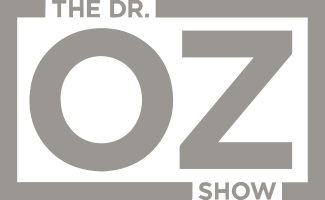
In this post, we’ll give you an overview of the DASH diet. This includes what it is, how to follow it safely and additional information about difficulty and supplementation.
We hope this post empowers you to make individualized dietary decisions alongside your healthcare provider.
What Is the DASH Diet?
The acronym “DASH” stands for Dietary Approaches to Stop Hypertension. Hypertension means “high blood pressure.”
The DASH diet is a reduced/low sodium diet that was created for people with high blood pressure.1-2 Over the years, the DASH diet has become a mainstream healthy eating plan.
The diet is balanced and flexible. It emphasizes several key nutrients that are often overlooked in the Western diet, more specifically:1,3
- Calcium
- Magnesium
- Potassium
- Fiber
- Lean protein
Related: How To Help Maintain Healthy Blood Pressure
DASH Diet guidelines: What to Eat on the Dash Diet
Unlike some other diets, the DASH diet does have structured guidelines. Following the DASH diet to a T will give you the most benefit.
Eat Foods Rich in Potassium, Calcium and Magnesium
These nutrients play a role in blood pressure regulation, and it’s important to include them in your diet.4 Make sure to eat healthy foods that contain these nutrients, such as:1.6-9
- Fruits
- Vegetables
- Whole grains
- Nuts, seeds, legumes
- Lean protein
- Low Fat dairy
Later on, we’ll give specifics about each food group and how much to eat on a DASH diet.
Limit Foods High in Sodium, Saturated Fat and Added Sugar
Sodium plays a role in fluid balance and blood pressure. Eating a diet high in sodium can increase your risk of hypertension (a risk factor for stroke and heart disease).5
A signature feature of the DASH diet is sodium restriction (<2300 mg per day or <1500 mg per day).10 For reference, a “soup and sandwich” meal with 8 ounces of milk can have over 3000 mg of sodium!11
The DASH diet also encourages limiting unhealthy saturated fat and added sugar.
| Sodium Foods to Limit1 | Saturated Fat Foods to Limit1 | Added Sugar Foods to Limit1 |
|---|---|---|
| Table salt | Full fat milk, yogurt and cheese | Fountain drinks |
| Seasoning mixes that contain sodium (garlic salt, seasoned salt) | Creams | Sports drinks |
| Canned foods | Salad dressings | Cakes, cookies, pies |
| Pre-seasoned food | Butter | Donuts |
| Processed, cured meats (salami, pepperoni) | Red and processed meat | Condiments with added sugar (ketchup) |
| Pre-packaged snacks (chips, crackers) | Fried foods | Sugar |
| Condiments | Juice blends (blends <100% fruit juice) | |
| Ice cream | ||
| Lemonade, juice cocktail |
Serving Recommendations on a 2000-Calorie DASH Diet
Along with what foods to eat, the DASH diet has recommendations for how much of these foods to eat.
Serving recommendations are based on how many calories you eat per day. While 2000 calories per day is the average, you may need to eat more or less. Consult a Registered Dietitian to determine your daily calorie needs and receive personalized guidance for DASH Diet meal planning to ensure you meet your nutritional goals.
Grains (6-8 servings per day)
Preferably whole grains such as whole grain bread, brown rice and whole grain pasta. Also includes ancient grains like quinoa, farro and millet.
Serving examples: 1 slice of bread, a small handful of crackers, ½ cup cooked rice1,10
Meat, Poultry, Fish and Eggs (0-6 servings per day)
Try to limit the amount of red meat, fried meat and processed meat you consume. These tend to be higher in saturated fat and sodium. Choose lean poultry, eggs and fish instead.
Serving examples: 1 egg, 1 ounce of meat1,10
Vegetables (4-5 servings per day)
Preferably fresh or plain, frozen vegetables. If you must consume canned vegetables, look for options that are low in sodium (check the food label). When cooking, avoid adding salt or sodium-containing seasonings.
Serving examples: 1 cup of leafy greens, ½ cup of other vegetables1,10
Fruits (4-5 servings per day)
Preferably fresh fruits or plain, frozen fruits. To cut back on added sugar, limit or avoid fruits that are packaged with syrups, juices or sweeteners.
Serving examples: 1 medium apple, ½ a banana, ½ cup of chopped fruit, 4 ounces of 100% fruit juice1,10
Dairy Products (2-3 servings per day)
Choose nonfat or lowfat options. Limit consumption of whole milk, full fat yogurt, ice cream, cheese, butter and creams.
Serving examples: 8 ounces of milk, 1 cup yogurt, 1.5 ounces of cubed cheese, 1 slice of cheese1,10
Fat and Oils (2-3 servings per day)
To cut back on unhealthy fats, limit butter, cream, coconut oil and palm oil. Instead, cook with liquid oils like olive, canola or vegetable oil. Or, include healthy fats from avocado and fatty fish (salmon, tuna).
Serving examples: 1 tsp margarine, 2 Tbsp dressing, 1 pat of butter1,10
Nuts, Seeds and Legumes (4-5 servings per week)
Note that this is a weekly recommendation. This includes nuts, nut butters, beans (dry or low-sodium), seeds and peas.
Serving examples: 2 Tbsp peanut butter, ⅓ cup of nuts, ½ cup of cooked beans1,10
Sweets (0-5 per week)
Note that this is a weekly recommendation. Limit consumption of cookies, cakes, ice cream, donuts, sugary beverages and alcohol.3
Serving examples: 1 Tbsp of jelly, 1 small cookie, 8 ounces of soda, 5 ounces of wine1,10
DASH Diet FAQs
We’ll answer some commonly asked questions about the DASH diet so you can better determine if it’s right for you.
What Are the Benefits of the DASH Diet?
There are a variety of benefits to the DASH diet. Here are a few to consider:
- Can lower blood pressure: Hypertension is a major risk factor of heart disease and stroke.1,5 Studies have shown that following a DASH diet can lower blood pressure in as little as 2 weeks.1
- Can lower LDL “bad” cholesterol: The DASH diet has also been shown to reduce bad cholesterol, which is another major risk factor for heart disease and stroke.1-2
Read More: Lifestyle Tips for Managing Cholesterol
Is it Hard to Follow a DASH Diet?
If you decide to follow the DASH diet, you’ll need a basic understanding of sodium, food label reading and serving sizes. This may be difficult if you don’t have support along the way.2 Luckily, there are many resources for the DASH diet. And if needed, consult a Registered Dietitian for an individualized DASH diet plan.
In terms of taste, people accustomed to high sodium diets may think the DASH diet tastes bland. With the help of non-sodium seasonings and a little time, many people adjust to the taste of lower-sodium eating.1
Are There Safety Concerns with the DASH Diet?
Prior to starting a new diet, consult with your doctor and/or dietitian. Certain diets can put you at risk for nutrient deficiencies, worsening of health status, and/or adverse drug-nutrient interactions.
Let’s talk about safety concerns with the DASH diet:
- Potential for initial GI discomfort: Some people may experience constipation, gas or bloating when they first start the DASH diet. This occurs when you increase fiber intake too quickly. This is generally temporary, but if symptoms persist, consult your health care provider.3
Do I Need to Take Supplements on a DASH Diet?
In general, it is best to obtain nutrients from food sources first. Supplements can be used to fill in nutritional gaps, meet specific nutrient needs and/or when one’s diet lacks certain nutrients.
Remember to consult with your doctor before starting or changing your supplement regimen. Supplements can play a part in your health status and may affect how certain medications work.
It is uncommon to experience nutrient deficiencies on the DASH diet.3 In fact, the DASH diet can be used to improve overall nutritional adequacy.
When you’re deficient, supplementation and/or dietary changes may be required. Supplementation should be discussed and analyzed by a healthcare provider prior to starting.
In Summary
The DASH diet is a safe, structured, flexible eating plan that can suit most people, even kids. It promotes various healthy eating habits like lowering sodium and eating more fresh foods. It’s also backed by favorable research.
References
1 Mayo Clinic. DASH diet: Healthy eating to lower your blood pressure. Mayo Clinic Website. Published June 25, 2021. Accessed March 1, 2023.
2 Harvard School of Public Health. Diet review: DASH. Harvard Health Publishing Website. Accessed March 1, 2023.
3 National Library of Medicine. Understanding the DASH diet. Medline Plus Website. Updated August 15, 2022. Accessed March 1, 2023.
4 Harvard School of Public Health. Key minerals to help control blood pressure. Published May 3, 2019. Accessed March 1, 2023.
5 Centers for Disease Control and Prevention (CDC). Sodium. CDC Website. Updated December 21, 2021. Accessed March 1, 2023.
6 Klemm S. DASH eating plan: Reducing blood pressure through diet and lifestyle. EatRight Website. Published February 11, 2021. Accessed March 1, 2023.
7 National Institutes of Health (NIH). Magnesium. NIH Website. Updated June 2, 2022. Accessed March 1, 2023.
8 Harvard School of Public Health. Potassium. Harvard Health Publishing Website. Accessed March 1, 2023.
9 Harvard School of Public Health. Calcium. Harvard Health Publishing Website. Accessed March 1, 2023.
10 National Heart, Lung and Blood Institute. DASH eating plan. NIH Website. Updated December 29, 2021. Accessed March 1, 2023.
11 Cooperative Extension Publications. Sodium content of your food. University of Maine Website. Accessed March 1, 2023.












